avant garde
Although it has come to signify those aesthetic practices which are unconventional, subversive, or simply bizarre, the term "avant-garde"-French for front or advance guard-was originally used in a strictly military context, where it referred to a small unit of especially skilled soldiers who marched ahead of their army and plotted its course. It was this meaning evoked by Olinde Rodrigues in his essay "L'artiste, le savant et l'industriel" (1825), which contains the first recorded use of "avant-garde" in its now-customary sense: there, Rodrigues calls on artists to "serve as [the people's] avant-garde," insisting that "the power of the arts is indeed the most immediate and fastest way" to social, political, and economic reform.1 Following Rodrigues, since the mid-nineteenth century "the avant-garde" has come to signify a more or less amorphous collective of highly innovative, path-breaking artists whose unorthodox ideological commitments manifest themselves in non-traditional approaches to artistic and cultural production. Such approaches tend to evince what may be the single most definitive characteristic of avant-gardism: namely, a highly-developed consciousness regarding the institutionalized practice of "art" itself. The avant-garde artist poses the question, "What is art?" without necessarily attempting to answer it, and it is this thematization of seemingly insoluble questions about the nature of aesthetics, art, and art-making that is usually-though not always-allied to a program of social and political radicalism.
In order to critique the state of art and artistic production in contemporary culture, avant-garde practices generally involve a significant revision of the relationship between the producer and his medium. Contrary to Clement Greenberg's formulation of avant-garde aesthetics in "Towards a Newer Laocon" (1940), most of what we now consider avant-garde art does not so much "surrender to the resistance of its medium"2 but rather draws attention to, undermines, and corrodes the sanctity of the conventions which prescribe that medium's customary usage. This does not mean simply that the avant-garde artist handles her materials in a manner different from the prevailing modus operandi, but rather that she interrogates the principle of medium specificity itself. Thus, while Jackson Pollock's application of paint to his canvas in drips and dribbles is extremely inventive, the absence of a relationship between his use of materials and a critical interest in the nature and practice of art excludes him from the ranks of the avant-garde.
Indeed, Greenberg's faith in Abstract Expressionism as the ultimate vanguard has been dismissed by most art historians, whose critical and historical accounts of avant-gardism emphasize its debt to the experimental art of the nineteenth century, and to those artists who demonstrated a prescient interest in questions of media. For example, Stephane Mallarm's development of a multimedia poetics, one rigorously preoccupied with the audio-visual as well as legible status of the printed word, identifies him as a forerunner of experimentalists like Guillaume Apollinaire, F.T. Marinetti, and e.e. cummings. According to Walter Benjamin, Mallarm "was the first [artist and poet] to incorporate the graphic tension of the advertisement in the printed page"3, undermining the sanctity of the poem as a purely artistic, autonomous production while underlining its covert status as cultural commodity.
Mallarm's interest in multimedia aesthetics is developed in the twentieth century by Dada artists like Kurt Schwitters, whose own vanguard movement, Merz, was committed to the production of a Gesamtkunstwerk ("total work of art") that included multiple genres and forms of media, including painting, sculpture, typography, architecture, and performance art. As Schwitters wrote in Merz, the journal of the Merz movement, in 1921:
The medium is as unimportant as I myself. Essential is only the forming. Because the medium is unimportant, I take any material whatsoever if the picture demands it. When I adjust materials of different kinds to one another, I have taken a step in advance of mere oil painting, for in addition to playing off color against color, line against line, form against form, etc., I play off material against material, for example, wood against sackcloth. 4
Schwitters' description of wood lying against sackcloth evokes his own work with collage, and recalls the central importance of the collage form to various vanguard movements in the twentieth century. For artists like Schwitters and Hannah Hch, the collage is a highly suggestive act of bricolage, a piecing together of materials that come to represent the fragmented nature of the culture from whose debris they are drawn. The images Hch uses in her photomontages are not the product of her own hand, but rather taken from magazines, newspapers, catalogues, and printed advertisements; mass (re)produced and circulated, they are images that seem to have no maker other than the printing press that churns them out.
The interpolation of mass produced, non-original images in an artifact evinces another characteristically avant-garde attitude towards "media" not as the materials of artistic production, but rather as the instrument(s) of mass communication. To include mass media images as part of an original work upsets conventional distinctions regarding what is and is not art, and suggests that the Kantian model of the art object's disinterestedness masks the unsettling reality [1,2] that all art is a form of advertising. This ambivalent synthesis of high art and popular culture characterizes the work of artists affiliated with vanguards like Pop Art, Fluxus, and Assemblage. For example, Andy Warhol's paintings of car crashes consist of canvases silkscreened with reproductions of grisly, but strangely quotidian newspaper photographs. Confronted with these all-too-familiar images of carnage in the rarefied space of the art gallery, the viewer is forced to acknowledge what David Joselit calls "the scandal of his or her own [habituated] indifference to the twisted and maimed bodies represented."
Joselit also claims that in Warhol's "photo-derived paintings," "events are not experienced through the direct participation, but rather through the 'official eye' of a newspaper reporter who is him or herself the avatar of a large corporation."5 This distantiation of the artist's and the spectator's gaze demonstrates the extent to which all experience of the modern world is literally mediated by the corporatized apparatus of mass media itself. As a form of media in both the material and instrumental sense, the art object is part of the informational network that obstructs rather than facilitates or clarifies our encounter with reality [1,2]. At the same time, Warhol's paintings suggest that there is no such thing as an immediate experience of "reality" [1,2], and that no event or sensation exists that has not been passed through a variably visible screen of media systems.
Warhol's interest in the unavailability of immediacy suggest an oppositional response to the earlier avant-gardism of the Surrealist movement, whose practitioners-including Andr Breton, Salvador Dal, and Max Ernst-attempted to represent, in Breton's words, "a transmutation of those two extremely contradictory states, dream and reality, into an absolute state of surreality." The efforts of the Surrealists to "systematize confusion and thus...discredit completely the world of reality,"6 were (and are) often condemned for being irresponsibly apolitical, geared towards the narcissistic production of phantasmatic images rather than the conscious reformation of current socio-political conditions. While some Surrealists (like Breton) were obviously politically active, the relative indifference of Surrealism to questions of media, and how such questions serve to critique the idea of art as such, distinguish it from the twentieth century's other avant-garde movements. The Surrealist's celebration of the unconscious mind seems theoretically as well as politically tame in comparison to such audacious interrogations of high art as Warhol's Crash paintings, or, perhaps more to the point, the work of their contemporary, Marcel Duchamp.
A provocative and playful examination of the institutional framework within which contemporary art is received and by which it is mediated, Duchamp's Fountain (1917) is the ancestral paradigm of installation art, a genre which increasingly exemplified avant-garde practice during the Cold War era. Duchamp's piece not only subverts habitual convictions about the materials appropriate for artistic production, but also raises the possibility that the conventions that structure our experience of art-including the art gallery, the show, exhibition, or opening, the critical review, the movement of spectators through the viewing space-are themselves a kind of medium, a means by which a message is altered as well as received. These are the principles that lie behind such theorizations of the museum as Marcel Broodthaers' Muse d'Art Moderne, Dpartment des Aigles (1968) or Hans Haacke's MoMA-Poll (1970). Both installations require that the spectator read not only the entire scene around him, but also his presence in that scene as part of the artwork; he is thus compelled to acknowledge his material complicity in the structure of the artwork itself, as well as the medial nature of his own subjectivity. By demonstrating how our experience of art is highly scripted by a series of cultural conventions, the installation piece deconstructs the assumption that an encounter with the aesthetic can ever be fully authentic, spontaneous, or unmediated.
The Minimalist vanguards of the 1960s and 1970s staged similar investigations into the multimedia encounter of art object, spectator, and viewing space. Filling the rooms of galleries with enormous structures of wood, metal, or plastic bent into simple geometric shapes, artists like Donald Judd, Robert Morris, and Tony Smith drew impassioned criticism from the likes of Michael Fried, whose essay, "Art and Objecthood" (1967) condemned such productions as "literalist", and, even worse, a form of "theater": "[T]he experience of literalist art," he claimed, "is of an object in a situation-one which, virtually by definition, includes the beholder."7 Nonetheless, Minimalism has received retrospective praise from critics like Hal Foster, who, in the 1990s, praised Minimalism as a mid-century renaissance of avant-gardism in the tradition of Duchamp8. Its interest in the spectator's sensation of (in Robert Morris' words) "establishing relationships as he apprehends [an] object from various positions and under varying conditions of light and spatial context"9 posits space and time themselves as meta-media, and human perception itself as a genre of aesthetic experience.
Despite Fried's charge of theatricality, most Minimalist art still maintains a highly intellectualized reserve, celebrating a coldness and austerity that provides a stark contrast to the hyperactive over-stimulus of popular culture. Thus Minimalism appears to stand in contradistinction to the contemporary genre of video art, which openly engages with that exemplary apparatus of the mass media-the television. However, if we credit Marshall McLuhan's categorization of television as a "cool" medium, one which requires a great deal of the spectator's cognitive participation to "close" the gaps in its informational "mesh", video art's similarity to the Minimalist installation becomes apparent: both Minimalism and video art demand from its audiences what McLuhan calls "a convulsive sensuous participation that is profoundly kinetic and tactile," where "tactility is the interplay of senses, rather than the isolated contact of skin and object."10 This total immersion of the self in the experience of spectatorship can lead to what Rosalind Krauss condemns as a "narcissism" endemic to the encounter with video art, a narcissism she also reads into the artist's exploitation of the television screen as a site of self-reflexivity and introspection11.
Krauss' discrediting of video betrays her suspicion of the introduction of pop cultural elements into high art, a trend-coextensive with postmodernism-that she condemns as a form of "complicit[y] with a globalization of the image in the service of capital."12 This is more or less a recapitulation of Clement Greenberg's argument in his seminal "Avant-Garde and Kitsch" (1939), which posits an aesthetic as well as a moral distinction between the two allegedly distinct genres. However, both Krauss and Greenberg repress the fact that most historical as well as contemporary vanguards probe the aesthetic integrity of various media by introducing overtly kitsch elements into their productions. We have seen how this is apparent in the work of Hch and Warhol, and kitsch becomes even more integral to those vanguards which embrace modern identity politics. Works like Kara Walker's silhouette cut-outs (c. 1990s-present) both expose the racist ideologies encoded in seemingly banal remnants of older mass cultures and transform them into emblems of racial empowerment. Re-appropriated as a medium of artistic production, the kitschy, sentimental silhouette becomes a critique of commodity culture, and of the system of racial and class oppression on which that culture depends. Meanwhile, Sianne Ngai has cited the use of kitsch imagery in contemporary Japanese art as an investigation of the "sadistic desires for mastery and control" aroused and stimulated by the practices of late-capitalist consumerism; by exposing the racial and gender stereotypes embedded in "cute" images or artifacts (including cartoons), the Japanese avant-gardist provokes in the spectator a particularly self-critical consideration of "the violence always implicit in our relation to the cute object."13
Nonetheless, the postmodern "globalization of the image" cited by Krauss is crucial to understanding the difficulty of producing truly avant-garde works in a postmodern capitalist culture. As Frederic Jameson argues, "aesthetic production [in the postmodern world] has become integrated into commodity production generally: the frantic economic urgency of producing fresh waves of ever more novel-seeming goods (from clothing to airplanes), at ever greater rates of turnover, now assigns an increasingly essential structural function and position to aesthetic innovation and experimentation."14 In other words, the avant-garde's crucial critical distance from the mainstreams of contemporary culture has been shrunk by its absorption into a growing network of interrelated markets: the cutting-edge piece of art, as well any non-conformist politics that accompany its making, have been neutralized through their commodification. Interestingly enough, Andreas Huyssen has traced the avant-garde's internal vulnerability to such ideological co-optation through its own biographical history, locating certain "subterranean links between avant-gardism and the development of capitalism in the twentieth century."15 Although Huyssen does not draw this conclusion explicitly, it seems reasonable to suspect that one such "subterranean link" may be the avant-garde's own obsession with the exponential proliferation and encroachment of media technologies in and upon modern society. As Jameson suggests, the avant-garde has become the object of its own critique-an uncritical medium of cultural reproduction.
Nevertheless, Hal Foster has argued that what he identifies as a recent "return of the Real" in contemporary avant-garde art suggests its resurgence, if not its wholesale regeneration. For Foster, "the Real" represents a site of total immediation that cannot be reached, but only approached asymptotically through experiences of extreme emotional, psychological, and bodily shock-through, in a word, trauma. Foster's neo-avant-garde (which includes artists like Zoe Leonard and Richard Prince) does not simply propose an aesthetics of rigorous corporeality as a counter to the dehumanizing virtuality of our media-saturated age, nor does it simply adopt the body itself as a form of "new" media. Rather, by exploring and experimenting with representations of the traumatized human body, it reinstantiates that body as the site where the "subject", wrested from the death-grip of postmodern critical theory, "rushes back as witness, testifier, survivor" possessed of an "absolute [epistemological] authority."16 The subject and its physical being become the media through which the horrifically unmediated experience of trauma is recorded, and their incorporation into the work of art charges aesthetics with the uniquely contemporary burden of adequately representing the body in pain.
Almost by definition, no avant-garde can be adequately theorized by its own time, but must await both historiographic and critical accounts to catch up, as it were, with its radical consciousness. A retrospective analysis of the cultural and political importance of certain types of media to certain historical moments should yield a dialectical synthesis of our contemporary perception of avant-gardes gone by with their own highly ironized records of self-presentation-namely, their artistic productions. Such artifacts reveal an unusually self-critical attitude towards their status as media embedded within modern capitalist culture, as well as their inevitable complicity with the ideologies that promote and sustain such a hyper-mediated way of life.
Image Gallery

Jackson Pollock, Convergence (1952)

Stephane Mallarmé, pages from Un coup de dés (1897)
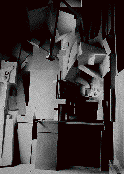
photograph of Kurt Schwitters, Hanover Merzbau (1930)
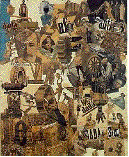
Hannah Hoch, Sliced with the Dada Kitchen Knife Through the Last Weimar Beerbelly Cultural Epoch Germany (1919-20)
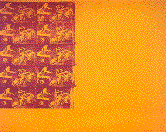
Andy Warhol, Orange Car Crash (1963)

Max Ernst, Oedipus Rex (1922)
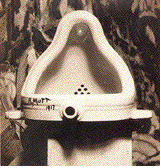
Marcel Duchamp, Fountain (1917)
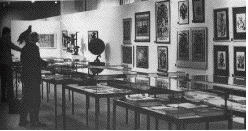
Marcel Broodthaers Musée d'Art Moderne, Département des Aigles (1968)
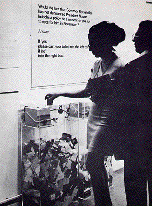
Hans Haacke, MoMa-Poll (1970)

Robert Morris, Corner Piece (1964)

Nam June Paik, Magnet TV (1965)

Kara Walker, Gone: An Historical Romance of Civil War As it Occurred Between the Dusky Thighs of Young Negress and Her Heart (1994)
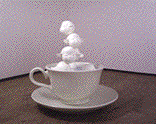
Yoshimoto Nara, Fountain of Life (2001)

Zoe Leonard, Pin-Up #1 (Jennifer Miller Does Marilyn Monroe) (1995)

Richard Prince, from the book Women (2004)
Anahid Nersessian